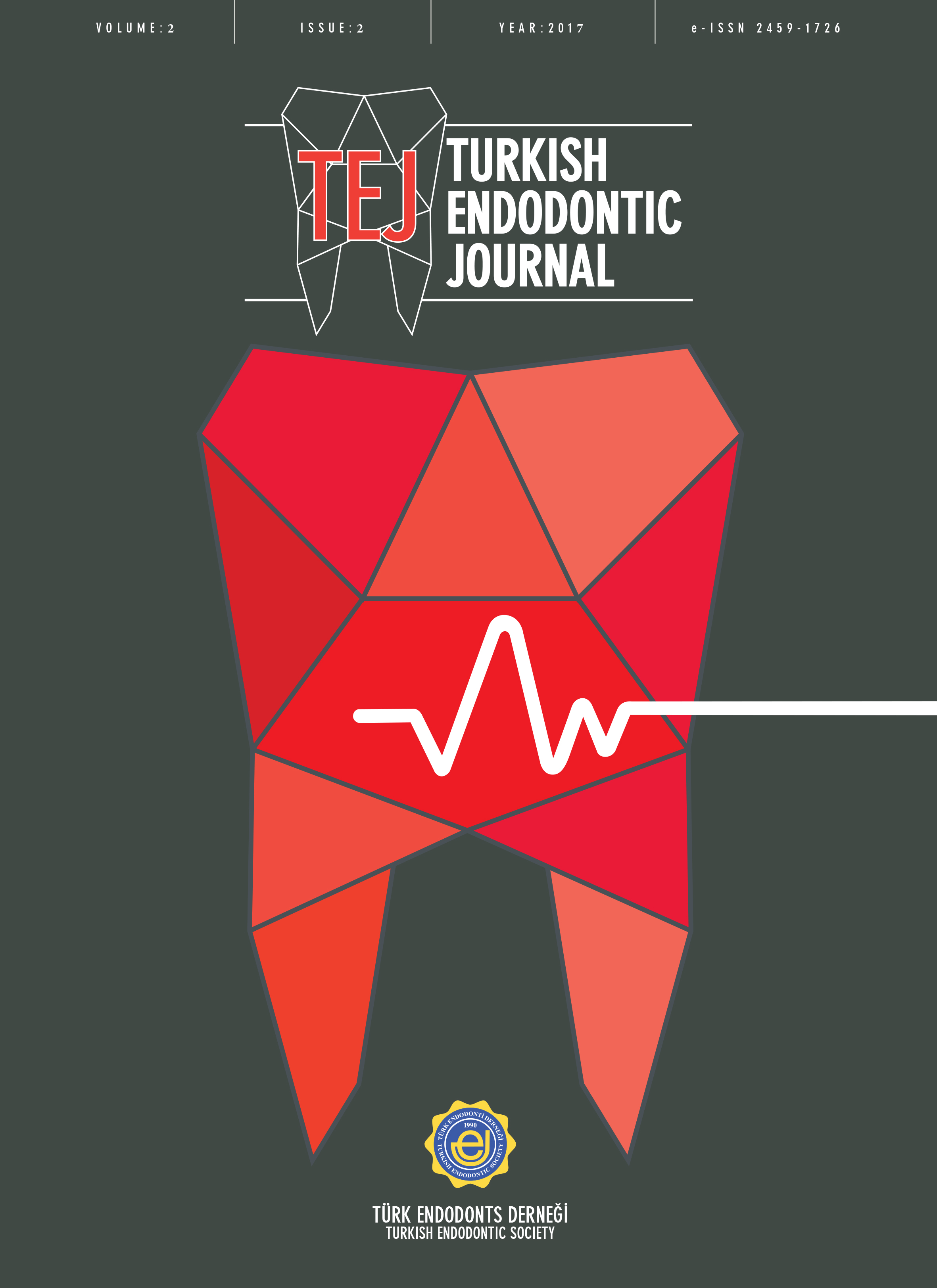Volume: 2 Issue: 2 - 2017
| EDITORIAL | |
| 1. | From the editor Jale Tanalp Page I |
| ORIGINAL RESEARCH | |
| 2. | Evaluating the effects of different protocols applied to resected root end on apical Gülter Devrim Kaki, Mukadder İnci Başer Kolcu, Serap Keskin Tunç doi: 10.14744/TEJ.2017.58066 Pages 25 - 30 Objective: This study aimed to investigate the effects of different protocols applied to the resected root end on apical sealing. Methods: In this study, 35 permanent lower premolars were chemomechanically prepared and obturated. Three mm of the root end was resected, and a 3-mm retro cavity was prepared using an erbium, chromium: yttrium-scandium-gallium-garnet (Er, Cr: YSGG) laser. The roots were randomly divided into four groups according to the protocol applied: group 1 (control group): no treatment was performed (n=5), group 2: Biodentine sealing (n=10), group 3: Biodentine sealing + Er, Cr: YSGG application, and group 4: only Er, Cr: YSGG application. The fluid filtration model was tested. The results were evaluated using one-way analysis of variance. Results: All groups showed leakage. No statistically significant difference was found between the groups (p≤0.05). The largest leak average was observed in group 1 (0.000373640±0.000135817 Lp) and the smallest leak (0.000270134±0.000136416 Lp) in group 3. Conclusion: The protocols applied did not completely prevent leakage of the resected root end; however, the use of Biodentine and the Er, Cr: YSGG laser led to less leakage. |
| 3. | Attitudes, materials, and methods preferred in root canal treatment in Turkey: a survey Can Topkara, Taha Özyürek, Ebru Özsezer Demiryürek, Tansu Bursalı, Murat Özler doi: 10.14744/TEJ.2017.30502 Pages 31 - 37 Objective: To obtain information about the treatment plans and the material and methods used by dentists in root canal treatments. Methods: The survey forms were e-mailed to the participants; overall, 275 volunteer participants were enrolled in the present study. The first 4 questions were related to the demographical data, the next 6 questions were related to the root canal treatment intervals and working length determination methods used by participants during the treatments, and the last 4 questions were related to the number of treatment visit and retreatment planning. The Chi Square Test was used to analyze the data at significance level of 5%. Results: It was determined that 10.5% of participants performed 1–2 root canal treatments per week. The rate of using rubber dam for saliva isolation was determined to be 16.7%, while remaining 83.3% of participants were found to prefer using cotton pellet. With respect to the institutions, the rate of use of rubber dam was found to be statistically significantly lower in public institutions. It was determined that the apex locator was the most preferred method in determining the working length. It was found that 53.1% of participants use only electronic apex locators, while 23.1% use the devices integrated to endodontic motor, and remaining 23.6% use and/or prefer both options. Conclusion: To increase the number of successful root canal treatments and make referring to the endodontist possible, it is recommended to support the educational studies the training. |
| 4. | Effect of different nickel–titanium rotary files on dentinal crack formation during root canal preparation in primary molars: a laboratory study Taha Özyürek, Gülşah Uslu, Koray Yılmaz doi: 10.14744/TEJ.2017.57966 Pages 38 - 42 Objective: To compare the dentinal cracks caused by Reciproc, WaveOne Gold, and ProTaper Next NiTi rotary file systems during root canal preparation in primary molars. Methods: Eighty mandibular primary molars with two separate and straight mesial canals were included in this study. The teeth were randomly divided into the following four groups: control, Reciproc, WaveOne Gold, and ProTaper Next. The 80 specimens were cut perpendicular to the tooth axis at 3-, 6-, and 9-mm distance from the apex, and using stereomicroscope, they were examined to determine the presence of any crack. Data were statistically analyzed by chi-square test using the SPSS 21.0 software. Results: Statistically significantly more dentinal cracks were found in the Reciproc, WaveOne Gold, and ProTaper Next groups than in the control group (p<.05). A statistically lesser dentinal cracks were observed in the WaveOne Gold and ProTaper Next groups than in the Reciproc group in terms of observed total dentin crack (p<.05). More dentinal cracks in the apical region were observed in the Reciproc group than in the WaveOne Gold and ProTaper Next groups (p<.05). Conclusion: Within the limitations of the study, statistically significantly more dentinal cracks were observed in the tested nickel–titanium file system groups than in the control group. |
| 5. | Comparison of cyclic fatigue resistance and shaping ability between two single-file reciprocating systems in curved canals Ezgi Doğanay Yıldız, Hakan Arslan, Meltem Sümbüllü, Mine Büker, İbrahim Şevki Bayrakdar, Ertuğrul Karataş, Muhammet Akif Sümbüllü doi: 10.14744/TEJ.2017.97269 Pages 43 - 46 Objective: To evaluate cyclic fatigue resistance in simulated canals as well as transportation, centering ability, and preparation time of two single-file reciprocating systems in curved canals of mandibular molars. Methods: Reciproc and NIC instruments (size 25) were tested in steel canals with 3 mm radius and 60° angle of curvature (n=20). The time to fracture was recorded in seconds. For the second part, 20 mesial root canals of mandibular first molars with curvature angles of 35°–70° and radii of 2–6 mm were instrumented using NIC and Reciproc instruments. Cone-beam computed tomography scanning was performed both pre- and post-instrumentation. Root canal transportation and the centering ratio were calculated, and the data were analyzed using independent sample t test (p=.05). Results: No significant differences were found between Reciproc and NIC instruments in terms of cyclic fatigue (p>.05). At 3, 5, and 7 mm levels, there was no significant difference in the root canal transportation and centering ratio between the groups (p>.05). Conclusion: Within the limitations of this study, cyclic fatigue values the root canal transportation and centering ratio of the NIC was similar to that produced with the Reciproc. |
| CASE REPORT | |
| 6. | Use of cone-beam computed tomography during management of a double-rooted maxillary lateral incisor: a 6-month follow-up case report Selin Göker Kamalı, Şeyma Şentürk, Dilek Türkaydın, Yıldız Garip Berker doi: 10.14744/TEJ.2017.09797 Pages 47 - 49 Internal anatomic variations in root canal systems affect the success of endodontic therapy. Missed canals and complex anatomic variations may cause endodontic failure. Maxillary lateral incisors frequently have a single root with a single radicular canal system. This case report describes the endodontic treatment of a two-rooted maxillary lateral incisor which was diagnosed using conventional radiography and cone beam computed tomography. |


















